
UJAK / UDOL
Special thanks to Joy Kovalycsik for sharing this material

Former Saros county, now Stara L'ubovna district
Initially founded in 1427 under the name WYAK 1786 Name changed to Ujak 1948 Name changed to Udol
Udol: the village lies on the left bank of the Poprad river. East of the village are some cliffs, [upper right photo] known as Skalky (the Rocks). Ammonites have been found here.
Skalky near Udol: A protected natural reserve of 0.75 ha in area, proclaimed on Aug 28, 1989. These are a part of the Pieniny section of the Carpathian chain. CHPV is made of eight rocky formations, of which three are almost bare rocky outcrops and five are overgrown with rich warmth-loving vegetation. The rocky cliffs are also interesting from a paleontological point of view.
Population figures:
These figures show that the village is somewhat smaller (average 900) for this region in Slovakia
Surnames found in the Greek Catholic Church of St. Dimitry for the villages of Udol (Ujak) and Hajtovka (which had no church).
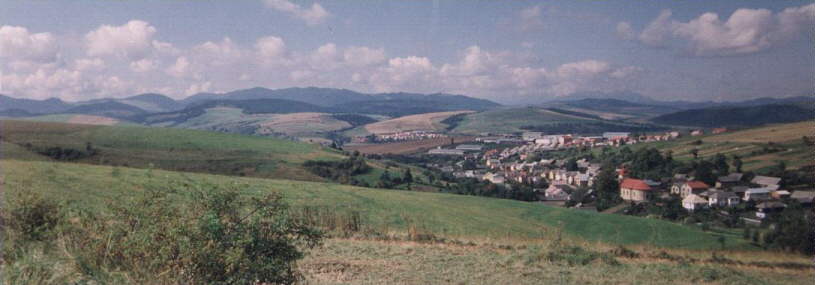
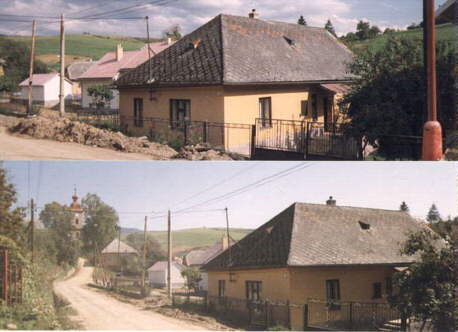
Photos courtesy of Julia Biss.

Young girl from Udol in authentic Rusyn dress
Immigration From the Village of Ujak/Udol to Passaic, New Jersey
The people who immigrated from the village of Ujak/Udol and surrounding village areas (Hajtovka, Maly Lipnik, Orlov, Circ) were forced to do so for various reasons. Being financially poor individuals with limited education, the chances for anything better than what they had were slim to none. In a monarchy environment the station you were born into was the station you died at and therefore, many made the decision to immigrate to America. It is interesting to note that from statistics drawn off immigration records (which are in no way conclusive) the total immigration from 1880 to 1908 from the former Austro-Hungarian Kingdom amounted to 2, 780,000 and of all the regions in the Hungarian Kingdom the counties of Spis, Saris, Zemplin, Uz and Bereg had the highest emigration rate of Carpatho-Rusyns. From December of 1879, Slavs first appeared in Passaic and would continue to arrive in this city for the next decade. Beginning in 1880 (with the Kovalycsik surname being one of the first Rusyn families to settle in Passaic, NJ) members of the village started to leave. The City of Passaic had always been an industrial city and with the building of the first railroad on First Street in 1886 it offered the expansion of the cities mills, shops and factories which needed a constant influx of manual laborers so that these businesses could grow. The close proximity of Jersey City to Passaic, New Jersey via train after the immigrant had passed through Ellis Island made Passaic a "first stop" of so many Carpatho-Rusyn families.
In 1890 a group of Rusyns from the village of Ujak/Udol met and decided to purchase the former Dundee Evangelical Mission Chapel on the corner of First and Bergen Streets and became St. Michaels Greek Catholic Church (the church being started by over 50% Rusyns and former residents of Ujak/Udol). The first priest of this church was Father Nicephor Chanath and the church continued to grow due to the large influx of more and more immigrants to the area. Most immigrants lived in cold water flats in the areas of First, Second (now Market), Third, Fourth and Fifth Street, known as the "Lower East Side" to local residents. Life was very hard and most took in boarders to pay expenses. A typical rental price for a boarder at the time might be about $3.00 a month for a place to sleep and for laundry and cooked meals. Most times, families took in friends and relatives from there own villages, you see this referenced again and again on census records. It is also interesting to note that as in Ujak, many families lived side by side as they did in Ujak here in America. As Passaic grew so did the population of immigrants which came to include Russians, Ukrainians, Polish, and a large Jewish population. Working in the factories was dangerous at best. Many workers lost arms, fingers or toes and sometimes their very own lives. This was at a time before any social programs or "safety net" disability payments and many were either severely injured or permanently disabled in industrial accidents. To meet the need for death and disability payments a fraternal society, the Greek Catholic Union was formed and held their first convention in Scranton, PA in 1893.
Representatives of the Passaic Lodge #12 were Peter Kovalycsik (my great-uncle) and George Molchan. The immigrants knew they had to take care of themselves as there would be no one else to do so for them here in their new country.
Problems presented themselves to the church built by the individuals from Ujak and during the 1920's due to the celibacy issues for priests (which was supposed to be guaranteed under the Union of Brest) and the forced latinization of the churches and in conjunction with the total disregard of the Latin Rite Catholic hiearchy in the United States for the Rusyn heritage and language (see Clash of the Titans, the dialog between Father Alexis Toth, Greek Rite Priest, when he presented himself before the Roman Rite Bishop, John Ireland to ask permission to function in the United States as a priest and the Bishop refused as Father Toth had been married) only fueled the flames and many of the members (not a few as some would say) chose to leave St. Michaels all together and start St. Johns Russian Orthodox Church on Lexington Avenue in Passaic. This was not the end of the problems and again, in the late 1940's when the church was forced to change their traditional Julian calendar for the Gregorian one this was the last straw for those that had remained and they too left to attend St. Johns.
Today, Passaic is no longer the Rusyn area that it once was, most have moved away or died, thus is the fate of all cities and new immigrants are taking their places on the same streets and tenement houses. As for St. Michaels Greek Catholic Church, a church that was started with such pride and hopes by many, many Rusyns from Ujak/Udol who were hard working, pious and wished to have a place where they could worship in their own traditions and language, it is sad to say that they would no longer recognize the church they started due to so many modern changes. Passaic, at one time could have been called "second Ujak" due to how many of its residents left their homes high in the Carpathian mountains with a prayer to God in silence that in America, they, but for sure their children, would have a better life in this great country.
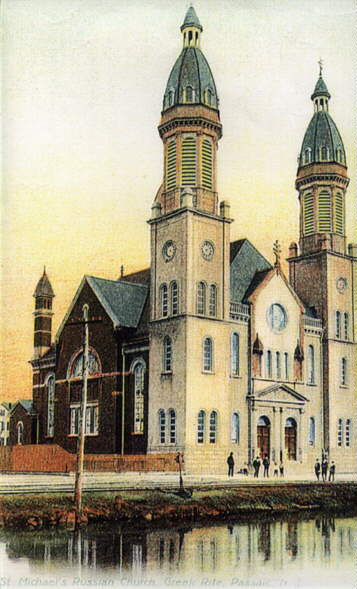
St. Michaels Greek Catholic Church, Passaic
circa 1910
from the private collection of Joy Kovalycsik
In Memory of my family:
Great Uncles John, Stefan and Nicholas, Great Aunts, Anna and Mary, Great Grandmother Anna Vancso Kovalycsik and my Grandfather, Michael Kovalycsik.
Garfield, New Jersey
The two photos below are of the cemetery cross and chapel of St. Peters Greek Catholic Cemetery in Garfield, New Jersey. In response to the constant influx of Rusyn and other Slavs to the areas of Passaic and Garfield the need was desperate to have a proper place of burial for Rusyn Greek Catholics. The only cemetery in the area at the time was St. Nicholas Roman Catholic Cemetery and they refused to recognize a Greek Rite priest, let alone permit any other burial rite than that of the Roman Catholic church. In answer to this prejudice a committee was formed in 1895 to purchase land for a cemetery so that Rusyns could be buried according to their own rites and traditions. Wanting to make sure this property would stay in Rusyn hands on March 24, 1897 St. Peters Greek Catholic Cemetery Association was formed by the following Rusyns: Officers: George Kmetz, J.Wilchovsky and P. Gladis, Directors of the Association were A. Zoscsak, J. Timko, M. Dudascsik, A. Gyucyak, G. Pircis and M. Mancyak (taken from stone tablets at entrance to Cemetery). This cemetery to this day is still in private hands and was for the most part exclusively Rusyn but due to changes in the times and a wish to sell off remaining graves the cemetery has been "opened" to any denomination wishing to purchase graves. It is the hope of the remaining owners to finally "close" the cemetery to further burial once all the ground is sold and will only remain open for those who hold title to be buried.
The cemetery is still in use by Greek Catholic and Orthodox members and one of the few cemeteries in New Jersey that cannot be accessed via car, you must walk from the main road in front of the main gates. The cemetery is still utilized every Memorial Day when priests from the Greek Catholic and Russian Orthodox churches hold a pannihida service for their members buried there. It is the only time the chapel is functioning now but years ago it was used most often. A interesting historical note for this cemetery is that years ago immigrants who could not obtain loans for banks or did not have a lump sum in cash to purchase cemetery plots could put a "lien" on their home properties until the purchase price was paid in full. One must give credit to the owners of this cemetery as this was no money making venture, some immigrants took years to pay off the entire purchase price and no Rusyn went without burial according to his own beliefs.
This cemetery cannot be overlooked for its historical aspects, all Rusyns who came to Passaic have at least one family member buried there and since many, many Rusyns first stop was Passaic after immigration the chances of vast amounts of people having a family member buried there is high. The cemetery still will do a search of surnames that you provide (for a modest fee) and will send photocopies of all that they may have in their old burial records. For anyone searching for their ancestors, the fee for this is nominal compared to the wealth of information to be obtained. St. Peters is a jewel not to be overlooked in anyones search for their Rusyn heritage. If anyone were to require the address of contact for this cemetery I would be happy to provide same via email.
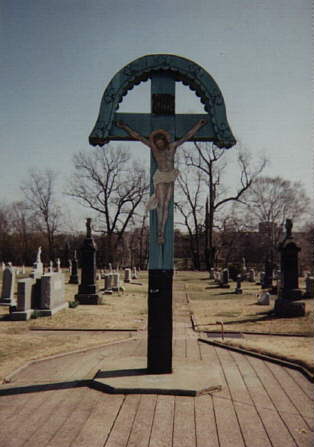
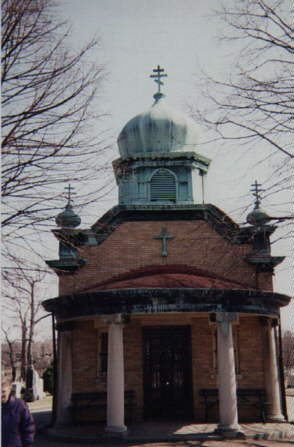
Researching any/all information in regard to the Kovalycsik/Kovalcik/Kovalscik families including Vansco, Biss, Kundrat, Kravchak, Stegena. Actual spelling of the name is Kovalcik and heritage is Carpatho-Rusyn (Ruthenian). Name was changed due to Hungarian spelling when immigration paperwork was issued. All above except Stegena surname came from Ujak, Saros, Eastern Slovakia (now renamed Udol) and immigrated to Passaic, NJ 1880 to 1910. Stegena surname originated from Orlov, Saros. Family were Greek Catholic but upon immigration some entered Orthodox parishes. Main line Father Michael Kovalycsik, Mother, Anna Belej, had five children, John, Michael, Peter, Anna and my Greatgrandfather, Andrew who married Anna Vansco and their children were: John, Stefan, Anna, Mary, Michael (my grandfather) and Nicholas. Father Andrew died on route to United States in 1909. All settled on Fourth Street in Passaic, New Jersey and attended St. Michaels Greek Catholic Church but then moved circa 1916 to Garfield, NJ. Stefan left New Jersey circa 1916 and relocated to Pittsburgh, PA. Am still searching for descendants of his first marriage to Helena a.k.a. Julia Kravchak, children who were Mary (who married William Wirostko) and John Kovalycsik (who married Mary Miskiv). Trying to also locate children and descendants of John Kovalycsik born 1885, died 1925, wife was Anna Repko children's names were Helen, Anna and Stefan. Any information on villages of Ujak (Udol) and Orlov in Eastern Slovakia would be appreciated. Family members of this surname still reside in Udol which I visited in 1996. The Kovalycsik family was very large in Passaic, New Jersey. Half Brothers and Sisters of my great grandfather (Michael Kovalycsiks second wifes name was Suzanna Szurgent) were Mary, Anna, Joseph and Nicholas (four others died in infancy in Ujak). Any information on this line, these villages or anyone who knew the Kovalycsik families would be greatly appreciated. I can be contacted via email anytime and would be happy to share any information with a family member who can prove lineage to my lines.
Contact:
Joy Kovalycsik
Garfield, NJ 07026
United States
Rusyn.from.ujak.joy@worldnet.att.net
Back to Rusyn Village Directory on the Carpatho-Rusyn Knowledge Base